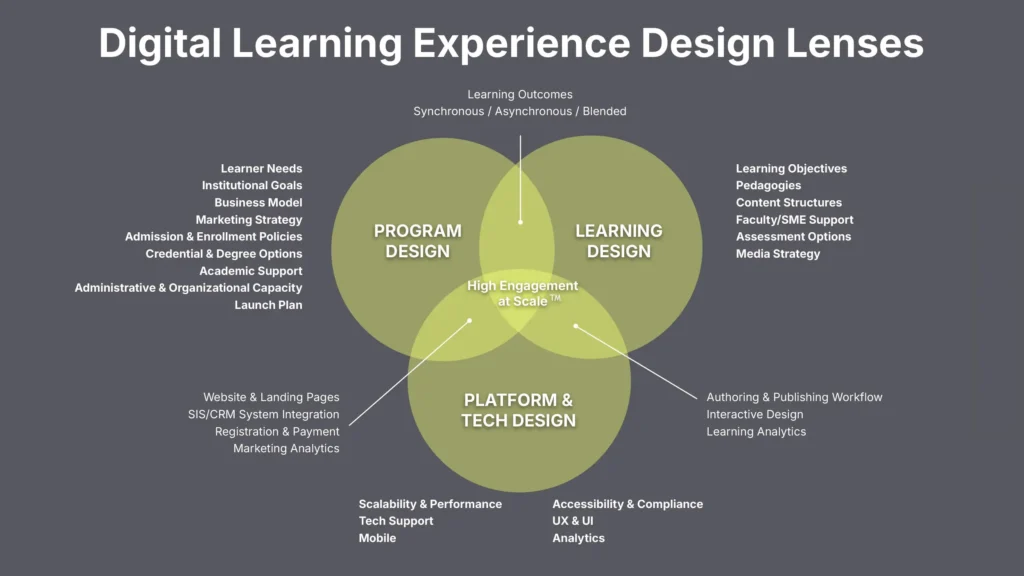Designing and building an online learning experience is a complicated process that must account for a wide range of factors to succeed. From business goals to learner needs, budget, and tech stack, it can be hard to know which pieces to prioritize, which decisions to make first, and how each element influences the others.
Studion’s approach to digital learning experience design organizes a potentially chaotic process into a logical and effective tool for decision-making. In our methodology, all factors are filtered through three lenses: program design, learning design, and platform and technology design.

In our 20 years of business, we’ve observed that organizations can reliably design, launch, and sustain digital learning experiences that achieve when they are designed through each of these three lenses.
Program Design: Understanding your organization and your learners
This lens surfaces insight into your organization’s capabilities and constraints and maps those to the needs and wants of the learner. Factors like business strategy, budget, and personnel support help us understand how to shape an online learning experience that makes sense for your company now and in the future. We rely on learning design best practices to understand and center learners. Many of the program design choices have learning and business implications, and Studion’s approach weighs the impact and sustainability of these choices for both the organization and the learner.
Key Question: What does a viable offering look like?
Program design factors:
- Learner Needs
- Institutional Goals
- Budget
- Business Model
- Marketing Strategy
- Admission & Enrollment Policies
- Certificate & Degree Options
- Personnel Support
- Administrative & Organizational Capacity
- Launch Plan
Learning Design: Mapping teaching goals to methods and content
Looking through the learning lens, we examine what we are trying to teach and match that to the method that will be most effective. We explore multiple user personas and use techniques like adaptive learning to design assessments and content tailored to their needs. Ultimately, we design learning experiences so that learners can truly understand the material and accomplish their learning objectives.
Key Question: What do learners want from an online learning experience?
Learning design factors:
- Learning Objectives
- Pedagogies
- Content Structures
- Faculty & SME Support
- Assessment Options
- Media Strategy
- Credentials/Certifications
Platform and Technology Design: Aligning on optimal technology solutions
Choices made in the first two lenses drive requirements for platform and technology design. There are three main approaches to the technical build of a digital learning platform – buy an off-the-shelf learning management system (LMS), build a fully custom platform, and a hybrid approach that creates a custom feel by modifying off-the-shelf and open-source components.
As a platform-agnostic firm, Studion is skilled in all three approaches. We help clients compare the pros and cons and find a solution that best meets their needs.
Key Question: What does a technically feasible solution look like?
Platform and technology design factors:
- Feature Set
- Branding/Skinning
- Integrations
- Scalability & Performance
- Tech Support
- Mobile
- Accessibility & Compliance
- UX & UI
- Analytics
Our guide is a helpful tool for creating a clear decision-making process and shared understanding of priorities. Applying it effectively requires a high level of collaboration between clients and our learning design team. We’ll work together to filter goals and requirements through these three lenses and bring into focus an effective strategy for your digital learning experience.



